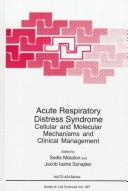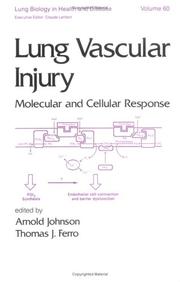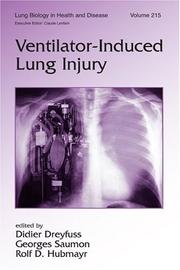| Listing 1 - 10 of 34 | << page >> |
Sort by
|

ISBN: 0306458306 Year: 1998
Abstract | Keywords | Export | Availability | Bookmark
 Loading...
Loading...Choose an application
- Reference Manager
- EndNote
- RefWorks (Direct export to RefWorks)
Book
Year: 1979 Publisher: Kalamazoo, MI : Upjohn Company,
Abstract | Keywords | Export | Availability | Bookmark
 Loading...
Loading...Choose an application
- Reference Manager
- EndNote
- RefWorks (Direct export to RefWorks)
Book
Year: 2018 Publisher: Bruxelles: UCL. Faculté de médecine et de médecine dentaire,
Abstract | Keywords | Export | Availability | Bookmark
 Loading...
Loading...Choose an application
- Reference Manager
- EndNote
- RefWorks (Direct export to RefWorks)
Since its description in 1967 by Ashbaugh et al. the acute Respiratory Distress Syndrome (ARDS- remains one of the deadliest pathologies found in the intensive care units. Although several authors have examined the histology of the ARDS and the correlation between mortality and diffuse alveolar damage (DAD), very few analyzed the therapeutic influence of open lung biopsy (OLB). Results: 51 patients met our inclusion criteria. 22 showed a DAD histology (43, 1%) and 29 a different one (56, 9%). The anatomopathological results were classified according to their cortico-sensivity. We found that the cortico-sensitive group had a lower mortality at 90 days (37% vs 65%, p= 0, 045) and at 180 days (37 % vs 75 %, p= 0,007). We were not able to identify any predictor of cortico-sensitivity. Conclusions: Our work shows that OLB is able to successfully identify patients who are the most likely to respond favorably to corticosteroid therapy. This identification is statistically correlated with a decrease in mortality at day 90 and day 180.Ours results, in agreement with the literature, suggest that the OLB remains, to date, the only tool at our disposal able to reliably identify the patients who are the most likely to respond to corticosteroid. Depuis sa description entre 1967 par Ashbaugh et al., le syndrome de détresse respiratoire aiguë (ARDS) reste une des pathologies les plus mortelles rencontrées aux soins intensifs. Bien que plusieurs auteurs se soient penchés sur l’histologie de l’ARDS et notamment sur la corrélation entre mortalité et une image de dommage alvéolaire diffus (DAD), les séries s’intéressant à l’influence thérapeutique de la biopsie pulmonaire se font beaucoup plus rares. Nous nous sommes proposés par cette étude rétrospective de déterminer l’apport diagnostique de la biopsie pulmonaire se font beaucoup plus rares. Nous nous sommes proposés par cette étude rétrospective de déterminer l’apport diagnostique de la biopsie pulmonaire chez les patients en ARDS et, dans un second temps, d’analyser l’influence qu’elle exerce sur la prise en charge des patients. Méthodes : Nous avons inclus tous les patients ayant été biopsies dans le cadre d’un ARDS entre janvier 2007 et mars 2017. Pour chaque patient, nous avons récolté et analysé leurs données démographiques, biologiques et ventilatoires dès le diagnostic d’ARDS posé et ce jusqu’à 7 jours après la biopsie pulmonaire. Résultats : 51 patients correspondaient à nos critères d’inclusion. 22 des biopsies montraient une histologie de DAD (43, 1%) et 29 une histologie différente (56,9%). Les résultats anatomopathologiques ont été classés sur base de leur cortico-sensibilité. Nous avons trouvé que le groupe corticosensible avait une mortalité inférieure à J90 (37% VS 65%, p= 0, 045) et à J180 (37% vs 75 %, p= 0,007). Aucun facteur prédictif de corticosensibilité n’a pu être mis en évidence. Conclusions : Notre travail montre que la biopsie pulmonaire permet l’identification de sous-types de patients les plus susceptibles de répondre favorablement à corticothérapies. Cette identification est statistiquement corrélée à une diminution de mortalité à J90 et J180. Nos résultats, en accord avec la littérature, suggèrent que la biopsie pulmonaire reste, à ce jour, le seul outil à notre disposition permettant d’identifier de manière fiable les patients susceptibles de répondre favorablement à une corticothérapie.
Book
ISBN: 3131666013 Year: 1979 Publisher: Stuttgart : Georg Thieme,
Abstract | Keywords | Export | Availability | Bookmark
 Loading...
Loading...Choose an application
- Reference Manager
- EndNote
- RefWorks (Direct export to RefWorks)
Book
ISBN: 0511575114 Year: 1999 Publisher: Cambridge : Cambridge University Press,
Abstract | Keywords | Export | Availability | Bookmark
 Loading...
Loading...Choose an application
- Reference Manager
- EndNote
- RefWorks (Direct export to RefWorks)
Acute Respiratory Distress Syndrome is the most lethal form of acute respiratory failure and presents one of the greatest challenges in critical care medicine. Yet despite its severity and complexity, few texts exist devoted to its diagnosis and management. After presenting the history and epidemiology of ARDS, clinicians will learn the basic science underlying its causes, and how to manage patients in the acute and later stages. Drs Russell and Walley, along with a team of expert contributors, clearly explain such clinical issues as mechanical ventilation, pneumonia, multiple system organ failure, and cardiovascular and pulmonary physiology and monitoring. An extensive chapter on clinical assessment demonstrates the importance of total patient care. Thoroughly referenced, superbly illustrated, and up-to-date, ARDS: A Comprehensive Clinical Approach is an indispensable source of information for intensivists, pulmonologists, internists, anesthesiologists, surgeons and any physician or nurse who rotates through the critical care unit.
Respiratory distress syndrome, Adult --- Pathophysiology. --- Treatment.
Book
Abstract | Keywords | Export | Availability | Bookmark
 Loading...
Loading...Choose an application
- Reference Manager
- EndNote
- RefWorks (Direct export to RefWorks)
Anaphylaxis --- Asthma --- Respiratory Distress Syndrome, Adult --- Anaphylaxis. --- Asthma. --- Respiratory Distress Syndrome, Adult. --- Respiratory Distress Syndrome.

ISBN: 0824787188 Year: 1992 Publisher: New York Basel Hong Kong Marcel Dekker, Inc.
Abstract | Keywords | Export | Availability | Bookmark
 Loading...
Loading...Choose an application
- Reference Manager
- EndNote
- RefWorks (Direct export to RefWorks)

ISBN: 084933716X 9780849337161 084933716X 9780849337161 Year: 2006 Publisher: New York: Taylor & Francis,
Abstract | Keywords | Export | Availability | Bookmark
 Loading...
Loading...Choose an application
- Reference Manager
- EndNote
- RefWorks (Direct export to RefWorks)
Book
Year: 1994 Publisher: London : W.B. Saunders,
Abstract | Keywords | Export | Availability | Bookmark
 Loading...
Loading...Choose an application
- Reference Manager
- EndNote
- RefWorks (Direct export to RefWorks)
ASTHMA --- LUNG DISEASES, OBSTRUCTIVE --- PULMONARY EDEMA --- PULMONARY EMBOLISM --- RESPIRATORY DISTRESS SYNDROME, ADULT --- PNEUMONIA --- ASTHMA --- LUNG DISEASES, OBSTRUCTIVE --- PULMONARY EDEMA --- PULMONARY EMBOLISM --- RESPIRATORY DISTRESS SYNDROME, ADULT --- PNEUMONIA
Dissertation
Year: 1990 Publisher: [S.l.] : [chez l'auteur],
Abstract | Keywords | Export | Availability | Bookmark
 Loading...
Loading...Choose an application
- Reference Manager
- EndNote
- RefWorks (Direct export to RefWorks)
OXYGEN --- FREE RADICALS --- LIPID PEROXIDATION --- RESPIRATORY DISTRESS SYNDROME, ADULT --- EXERTION --- METABOLISM --- OXYGEN --- FREE RADICALS --- LIPID PEROXIDATION --- RESPIRATORY DISTRESS SYNDROME, ADULT --- EXERTION --- METABOLISM
| Listing 1 - 10 of 34 | << page >> |
Sort by
|

 Search
Search Feedback
Feedback About UniCat
About UniCat  Help
Help News
News